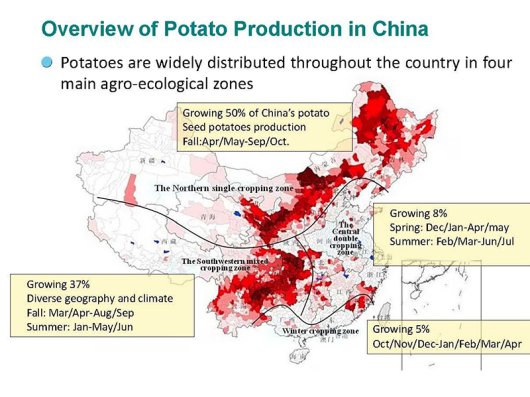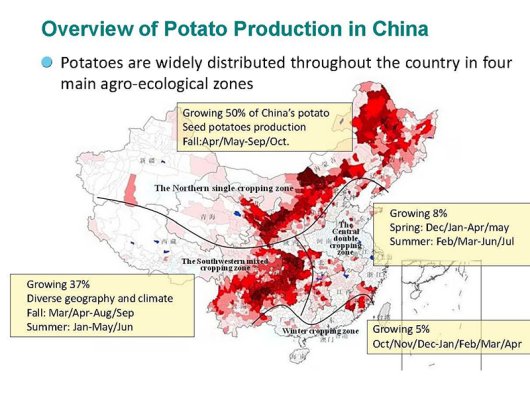Wageningen, The Netherlands
March 12 2015
Door Plant Research International (PRI)

Verhoging van de aardappelopbrengst heeft in China hoge prioriteit. Nu en in de nabije toekomst moet een grote inspanning geleverd worden om de stijgende vraag naar aardappel voor de verse consumptie en voor de industrie bij te kunnen houden. In een gezamenlijk R&D programma onderzoeken Chinese en Nederlandse instituten en bedrijven mogelijkheden om de aardappelproductie te verbeteren. In ‘Progress Report China Potato GAP project’ zijn de tot op heden behaalde resultaten te lezen van het Pubic Private Partnership (PPS) Potato GAP China.
Mondiaal gezien is aardappel één van de vijf belangrijkste voedselgewassen. Miljarden mensen worden hiermee voorzien van een gezonde basisvoeding. China is met een opbrengst van 70 à 80 miljoen ton per jaar op een areaal van 5 miljoen hectare wereldwijd de grootste aardappelproducent. Nederland staat slechts op nummer 10 met rond de 8 miljoen ton per jaar op 175.000 ha. De gemiddelde opbrengst per ha is in China rond de 20 ton, terwijl die in Nederland meer dan 45 ton is. Middels de introductie van Good Agricultural Practices (GAP) en verbetering van kwaliteitscontrole en voorlichting moet het mogelijk zijn om in China de aardappelproductie te verhogen.
In de afgelopen 30 jaar zijn in Nederland meerdere relevante technologieën en decision support systemen ontwikkeld ten behoeve van duurzame gewasbescherming. In China heeft men belangstelling voor deze methoden om daarmee duurzaamheid, opbrengsten en saldi te verbeteren, en te kunnen voldoen aan internationale standaards voor GAP.

Overzicht van de aardappel-productie in China (bron: YAAS, 2015)
R&D programma
Op initiatief van de Chinese en Nederlandse ministeries van Landbouw is een gezamenlijk R&D programma ontwikkeld, waarin meerdere Chinese en Nederlandse instituten en bedrijven deelnemen. Dit samenwerkingsverband richt zich op tenminste de volgende vijf topics:
- Kwaliteit van het pootgoed, veredeling, productie en certificering
- Good Agricultural Practices voor de aardappelteelt, met nadruk op bestrijding van Phytophthora
- Mechanisatie, machines en oogsttechniek
- Opslag en bewaring
- Demonstratie en kennisoverdracht.
Het meeste onderzoek is uitgevoerd in de noord-oostelijke provincie Heilongjiang. Dit is de belangrijkste aardappel-producerende provincie van China met een jaarlijkse oogst van ongeveer 8 milijoen ton, vergelijkbaar met de totale jaarproductie in Nederland.
Resultaten tot nu toe geven aan dat een grote verbeterslag is te maken door te werken aan een bewustwordingsproces aangaande het belang van een goede pootgoedkwaliteit en goede grondbewerking, gepaard aan een effectiever monitorings- en certificeringssysteem voor pootgoedkwaliteit.
Bestrijding van Phytophthora
In China wordt vooruitgang geboekt in de bestrijding van Phytophthora middels de introductie van monitoring en van een nationaal opererend decision support systeem. Echter, uit onze testen is gebleken dat het systeem verbetering behoeft om daarmee effectievere adviezen voor boeren te kunnen genereren. Boeren dienen ook echt uitvoering te geven aan de aanbevelingen van het adviessysteem en moeten in staat zijn daarbij passende technologie en fungiciden toe te passen. Ook zullen verbeterde bewaringsmethoden bijdragen aan hogere productkwaliteit en aan verlaging van verliezen tijdens opslag.
Ontwikkelen communicatiestrategieën
In dit samenwerkingsproject is veel ingezet op communicatie van de resultaten. In het algemeen is meer inspanning nodig om kennis over Good Agricultural Practices binnen China te verspreiden. Daarbij is het verstandig om per provincie of streek specifieke communicatie-strategieën te ontwikkelen, ingestoken op daar heersende culturele en socio-economische omstandigheden. De invoering van nieuwe technologieën, betere rassen, duurzame teeltmethoden en een effectievere kennisverspreiding zullen de aardappelproductie in China naar een hoger plan brengen.
China - Netherlands cooperation on improvement of China potato production
Raising China potato production is of utmost importance. In the coming years a great effort is to be made to meet the increasing demand of potatoes for fresh consumption and for industry. In a joined R&D program Chinese and Dutch research institutes and companies investigated opportunities for improvement on the main topics of potato production. ‘Progress Report China Potato GAP project’ describes the mid-term results of the R&D program of the PPS Potato GAP China.
Globally, potato is one of the top five of most important food crops. It provides billions of people with a healthy (staple) food source. China is the biggest producer of potatoes in the world, with 70 to 80 million tonnes per year in recent years, grown on about 5 million hectares. The Netherlands only ranks number 10, with a volume of around 8 million tonnes per year grown on about 175.000 ha. Where the average production per ha in China is around 20 tonnes per ha, it is in The Netherlands over 45 tonnes per ha. China can increase her potato production by introducing Good Agricultural Practices (GAP) and quality control and extension systems as applied in The Netherlands.
The Netherlands has developed many relevant technologies and decision support systems for sustainable crop protection during the past 30 years. China is interested to introduce these methods in her agricultural system, to improve yields, financial results and sustainability and to meet international GAP-standards.

Overview of potato production regions in China (source: YAAS, 2015).
Initiated in 2008 by the Chinese and Dutch Ministries of Agriculture a Sino-Dutch R&D program was developed in which several Chinese and Dutch research institutes and companies are participating. The consortium focusses on at least five topics:
- Seed potato quality, breeding technology, production and certification.
- Good Agricultural Practices (GAP) for potato cultivation, with a focus on late blight
- control.Machinery, equipment and harvesting technology.
- Storage technology.
- Demonstration & know how transfer.
Most of the studies were done in Heilongjiang province (north east China). Heilongjiang is an important potato producing province with an annual potato production of about 8 million tonnes, comparable to the total annual potato production of the Netherlands.
Late blight control in China
Results so far indicate that great improvements can be made by raising the awareness of the importance of good seed quality and good seed bed preparation in combination with a more effective seed potato quality monitoring and certification system. Late blight control in China has been improved through the introduction of monitoring system and a nation-wide decision support system. However, when looking at the efficacy trials, the decision support system requires improvement to be able to deliver effective advices to farmers to better protect their potato crops against late blight disease. Also, farmers have to comply with the recommendations of the advisory system and should be able to employ good technology and good fungicides. Upgraded storage methods will contribute to better quality of potatoes and reduce losses.
Tailor-made dissemination strategies
In the project many communication activities took place. However, more efforts are needed to disseminate GAP knowledge to the end users in China. A good way to do this, is to develop tailor-made dissemination strategies per province or region in China to match relevant Chinese cultural and socio-economic conditions. It is to be expected that China’s potato production will grow through the introduction of new technologies, better varieties, sustainable methods and more effective knowledge dissemination.